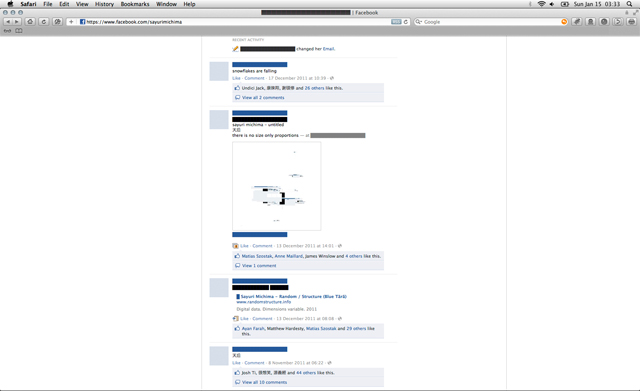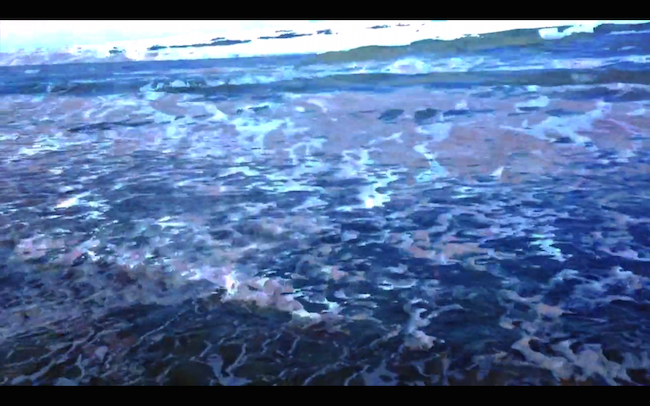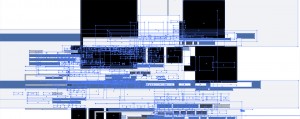Influential post-industrial sound alchemists Coil once implored us to Worship the Glitch, and it’s true that errors and flaws have long been perceived as having an essentially spiritual nature: they serve as testimonies, gateways, and admonitions against human hubris. According to shared beliefs across cultures as varied as the ancient Persians, Native Americans and medieval Europeans (e.g. the Celtic monks’ Book of Kells‘ purposefully-positioned errors and omissions), mistakes should be deliberately incorporated in any work one does, as humble declaration of the author’s inadequacy and renunciation of any claim towards godliness. The Japanese wabi-sabi aesthetic (an appreciation of imperfection), is deeply embedded in Buddhist philosophy and accepts flaws as an inherent aspect of the state of things; of their inevitable transience and incompleteness. Similarly, Salvador Dali claimed that mistakes are “of a sacred nature”, and that instead of correction, one should rather welcome and redirect them. From this perspective, digital glitch art may be seen as a coaxing of the ghosts from the machine, the paradoxical humanisation of the perfectly calculable and predictable. After all, errare humanum est.
Machines inherently encourage the quest for perfection, though not always in the domain of their creative use –as novelist Colson Whitehead summarised in The Intuitionist, “it is failure that guides evolution; perfection offers no incentive for improvement”. Hence producer Kim Cascone, in his post-digital recognition manifesto, located glitch music in a wider spectrum of sound based on the “aesthetics of failure”. Indeed, musicians are the artists who have explored the potential of error and deformation to the greatest extent, especially within the ‘cerebral’ strain of 90s/00s techno. The idea itself can be traced back to the Italian Futurists, seeking inspiration in motorised distortion and promoting ‘noise-sound’, and then on through a series of evolutionary steps in the aestheticisation of the mechanical flaw throughout the analogue era, which encompass John Cage (preoccupied with ‘indeterminacy‘ via his studies in Zen Buddhism), doctoring pianos with nails, erasers and jammed paper, and then revelling in the unpredictable outcome of each performance, or equally surf rock guitarists Dick Dale and Link Wray, deliberately hacking amplifiers and speakers after accidental (but aesthetically pleasing) discoveries when they were overloaded and blown. ‘Glitch electronica’, as it came to be known, drew both from the school of philosophical-epistemological enquiry (indeed Mille Plateaux, figurehead label of the movement, took their name from the Deleuze and Guattari text), and from the physical modification of equipment (Oval’s famous affixing strips of tape to CDs in order to encourage them to skip). This music –embodied in such divergent examples as the filigree trickery of Mouse on Mars, or the frequency manipulations of Ryoji Ikeda –emerged as an aesthetic of creative surprise at a time when techno had hit a rut of entropic predictability, eventually becaming a settled, relatively codified genre in its own right.
Glitches snuck into the wider art world when they became a ubiquitous part of contemporary life; the unwelcome but inevitable concomitant of the computer. Like mischievous visitors from another dimension, they would emerge uninvited on the screen to halt software, pixelate images, and cause sound files to skip or slow. It would seem that the ‘trickster in the machine’ likes to colonise new terrain, moving from traditional to digital media: in printers’ professional slang, mistakes –missing letters or jumbled word order –were commonly known as ‘printing gremlins’. In digital art, glitches, errors and bugs have become aestheticised, befriended and boldly explored. Embraced as desirable apparitions, and later intentionally achieved via means of creative destruction –circuit-bending, hardware customisation or code manipulation –they reveal patterns, shapes and colours akin to classic psychedelic art (perhaps unsurprising, given that avid psychonauts describe the LSD experience as ‘digital’, as opposed to the ‘analogue’ effects of psilocybin). Easy to create nowadays, stripped of the need for expensive equipment (e.g. via the plethora of online generators, or the Glitché app, which allows the user to distort images on their iPhone), and seeking its power via arbitrariness, glitch art has ultimately developed into a democratic form, one which evokes the way that the internet was (and, at its best still can be) perceived.

As once occurred in electronic music, the glitch aesthetic has become established in the visual strain of the digital arts, presented via its own official biennials (The Wrong), collected, somewhat illogically, in analogue anthologies (Glitch: Designing Imperfection), and eventually filtered through to mainstream music videos (Kanye West and Kid Cudi’s ‘Welcome to Heartbreak’). Much like Alarm Will Sound’s acclaimed acoustic renditions of Aphex Twin material (and, indeed, the whole ‘Unplugged’ musical current of the last couple of decades), certain artists even aim at reversing the elusive ghost’s jump from analogue to digital, thereby spreading the malfunction beyond its original environment. Glitch Textiles, one of the most renowned examples, transform data into physical fabric patterns; the results, available as blankets, resemble the creations of eccentric Italian knitwear label Missoni (known for hiring the occultist, pop-cultural alchemist Kenneth Anger for a 2010 ad campaign). Italian architect and designer Ferruccio Laviani even built a trompe l’oeil ‘glitched’ wooden cabinet, recreating a digitally distorted shape using traditional carpentry and carving techniques. Japanese artist Sayuri Michima recently took ubiquitous Facebook templates, disassembled and muted their elements, and printed them out in paper form. Michima’s Facebook and Tumblr accounts offer glitch-as-minimalism: in her work, the standardised tools of social communication become stripped of content, leaving just white spaces, black rectangles and blue lines. Much as the glitch electronica genre did for music, her work uses aesthetic disorder and interruption in order to explore philosophical uncertainty. Do her denuded shapes embody the ultimate void of digital space, signifying the disappearance of the user in a glitched vortex (“Sorry, but you are looking 辞世の句 for something that isn’t here”, her Tumblr states), or, conversely, is the blue Facebook header line –as per artist Edward Krasinski’s signature blue Scotch tape relentlessly wrapping public and private spaces –a quietly forceful symbol of presence?
Regardless of its currently fashionable prominence, glitch art therefore retains its status as a powerful tool for evoking questions, uncertainties and their embodiment as apparitions. Movement veteran Kim Cascone equates glitch with Brian Eno’s Oblique Strategies cards and Cage’s work with the I Ching, perceiving it as a method of divination or “errormancy”. With its embrace of indeterminacy and “things as they come”, glitch art recalls the words attributed to the legendary founder of the quasi-mystical Hashashin order, Hassan-i Sabbah, a guiding light of many subsequent magickal movements: “nothing is true; everything is permitted”. **
“Instead of the possibility of repetition, we are faced in life with the unique qualities and characteristics of each occasion.”
“Things as they come, as they happen, rather than as they are possessed or kept or forced to be.”
– John Cage
All images courtesy Sayuri Michima.
share news item



